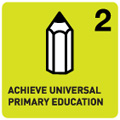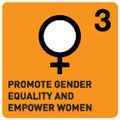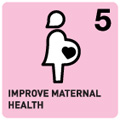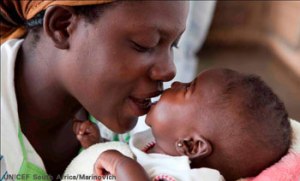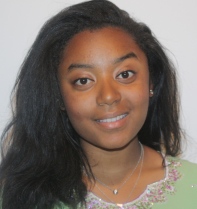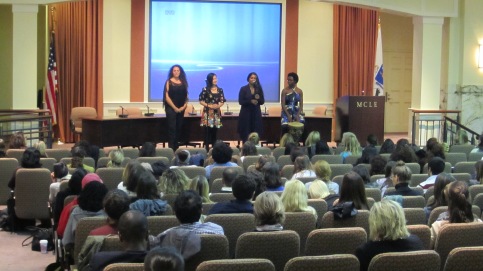2015 Millennium Development Goals
The Millennium Development Goals (MDGs) are a set of objectives that provide a framework commonly agreed upon by United Nations member states towards the betterment of the international community. In the year 2000, the United Nations adopted the Millennium Development Goals, in which the 193 United Nation member states and 23 international organizations signed off of on working to achieve specific goals, targeting issues to further the development of the social and economic well-being of people across the world. There are eight goals in total and each focuses on an important global issue and their effects that can be felt across the globe.
The first Millennium Development Goal is to eradicate extreme hunger and poverty. The combined efforts of member states within the United Nations have led to a significant decrease in extreme poverty. According to the World Bank more than half of the developing world lived on less than $1.25 a day in 1981. This figure has sharply decreased as of 2010, when the statistic decreased to 21%. However, in 2010 alone there were still 1.2 billion people living in poverty. Therefore, the international community still has many strides to take towards fulfilling the first millennium goal.
The second Millennium Development Goal focuses on achieving universal primary education. This particular goal entails the insurance that all boys and girls will complete a full course of primary schooling by 2015. Another aspect of this goal is the promotion of the concept that educating girls will advance development for all. There has been great success in the quest to reach this particular MDG as the percentage of enrollment in primary education in developing regions has increased from 82% in 1999 to 90% by 2010. However, there is still work to be done as currently 123 million youth, ages 15 -24, lack basic reading and writing skills around the globe.
The third Millennium Development Goal seeks to promote gender equality and empower women. Since 1990 there has been great improvement in gender equality. According to the United Nations, on a global scale women are moving out of the agricultural sector and into the non-agricultural sector as they hold 40 out of every 100 wage earning jobs in the non-agricultural sector. This increase is significant, yet there is still much to do in order to eliminate gender disparity at all levels of education and empower women across the globe, as only 2 out of 130 countries have the goal at all levels of education.
The fourth Millennium Development Goal focuses on the reduction of child morality and seeks to reduce the under-five morality rate by two thirds between 1990 and 2015. According to the United Nations Children’s Fund (UNICEF), 13 children under the age of five die each minute of everyday mainly from preventable causes. However, there has been hope for this MDG as the under-five morality rate has declined from 12.4 million in 1990 to 6.6 million in 2012. Also the utilization of measles vaccines since 2000 has prevented 10 million deaths.
The fifth Millennium Development Goal aims to improve maternal health by reducing the maternal mortality ratio by three quarters and achieve universal access to reproductive health. The efforts of UN member states have decreased the maternal mortality ratio by 47% since 1990. States cannot rest on this success as nearly 50 million babies are delivered worldwide without skilled care and the maternal morality ratio in developing regions is 15 times higher than that of developed regions.
The sixth Millennium Development Goal seeks to combat HIV/AIDS, Malaria and other disease by halting and beginning to reverse the spread of HIV/AIDS by 2015, achieving universal access to HIV treatment by 2010 for those who need it, and halting and beginning to reverse the incidence of malaria and other major diseases by 2015. According to the UN, new HIV infections continue to decline in most regions. However, the goal of universal access to treatment was missed by 2011. A positive aspect of this particular MDG is that the fight against malaria has seen great success as the global estimated instance of malaria has decreased by 17% and malaria specific morality rates have decreased by 25% as reported by the UN.
The Millennium Development Goal is centered towards ensuring environmental stability. There have been many successes towards reaching this MDG such as the reduction of over 98% in the consumption of ozone depleting substances since the adoption of the Montreal protocol. But countries are still struggling with combining their efforts to create a comprehensive treaty that focuses on a key factor affecting the environment, global climate change, as can be seen from the increase in emissions of carbon dioxide by over 46 percent since 1990, as reported by the UN.
The eight and final Millennium Development Goal is geared towards the creation of a global partnership for development. This particular goal focuses on the following points:
- Develop further an open, rule-based, predictable, non-discriminatory trading and financial system
- Address the special needs of least developed countries
- Address the special needs of landlocked developing countries and small island developing States
- Deal comprehensively with the debt problems of developing countries
- In cooperation with pharmaceutical companies, provide access to affordable essential drugs in developing countries
- In cooperation with the private sector, make available benefits of new technologies, especially information and communications
The eighth Millennium Development Goal has proven to be an intricate and difficult process with states taking small steps towards fulfilling the requirements of the goal due to issues that conflict with their own interest.
With 2015 approaching, Secretary General Bank Ki Moon, and the United Nations continue to push to achieve some of the mandated targets that still call for action. This year, 2014, is the call to action to focus on the Issues that still need attention, focusing on world hunger, with one in eight people still suffering from world hunger. A demand for more medical attention is needed for women and children, as maternal mortality and child mortality still remaining high. This is certainly something that deserves more focus, as the advancements in science and technology have made the medicine available to potentially save these lives. Furthermore, sustainable development and sanitation infrastructure also need more attention, as our finite resource base continues to decline, while 2.5 billion people still lack proper sanitation resources, also posing a major hazard to both public health and the ecosystem.

Secretary General Ban Ki Moon speaks at a press conference to launch the 2010 Millennium Development Goals Report. (Photo by People’s Daily Online)
Furthermore, while it may not be indubitable that all eight target goals will be met in 2015, it will certainly provide for an opportunity to refocus the priorities of the Millennium Summit, and ensure the post-2015 Goals are not only built off the base of the first set of Millennium Development Goals, but accomplished with higher efficiency, to provide for a more balanced rate of progress across all Global Issues. With Post-2015 bringing in a new set of goals, the issues placed at the forefront of the agenda will focus on sustainable development and will heavily involve the Economic and Social Council (ECOSOC) in its implementation process.
The Millennium Development Goals have given States the opportunity to work together in order to create a brighter future for all of mankind. Although some objectives within the mandates may not be achieved by 2015, the implementation of the Millennium Development Goals have lead to a breakthrough in moving in the right direction towards solving the global issues through a more unified approach, bringing issues such as the HIV/AIDS pandemic, poverty, world hunger, and environmental pollution to the attention of people all around the world.
Inspiring Change through Education: Women’s Forum @ UNA-GB celebrates International Women’s Day early with a screening of Graceland Girls!
 This past Monday, March 3, UNA-GB members and friends learned about the power of education through a film screening of Graceland Girls and panel discussion with global education activists and experts! Following a lively reception and the screening, the Women’s Forum hosted panelists Jordan Salvatoriello, director of Graceland Girls; Monte Allen, Senior Director of CARE; and Richard Rowe, Chairman and CEO of Open Learning Exchange (OLE). Some of the questions posed by Women’s Forum members and the audience centered around Ms. Salvatoriello’s experience in Kenya while filming the documentary, ways in which organizations like CARE and OLE are partnering with local communities in the developing world to provide education, and how members of the greater-Boston community can become global education advocates.
This past Monday, March 3, UNA-GB members and friends learned about the power of education through a film screening of Graceland Girls and panel discussion with global education activists and experts! Following a lively reception and the screening, the Women’s Forum hosted panelists Jordan Salvatoriello, director of Graceland Girls; Monte Allen, Senior Director of CARE; and Richard Rowe, Chairman and CEO of Open Learning Exchange (OLE). Some of the questions posed by Women’s Forum members and the audience centered around Ms. Salvatoriello’s experience in Kenya while filming the documentary, ways in which organizations like CARE and OLE are partnering with local communities in the developing world to provide education, and how members of the greater-Boston community can become global education advocates.
 Graceland Girls tells the story of high school students at the Graceland Girls School in central Kenya, an educational environment available to girls who were “fortunate and bright enough to receive sponsorship.” Many of the girls come from remote areas in Kenya, where their parents struggle to provide for themselves and their families. At various points in the film, the girls express the responsibility and pressure they feel to succeed in school and their future lives so that they can support their families. “Seen as their last chance for a better fate than that of their parents,” the girls’ stories reflect an awareness about the importance of their hard work. When asked what they want to pursue after going to university, many of the girls confidently list occupations such as “lawyer” and “neurosurgeon.” Faced with difficult circumstances and seemingly unsurpassable obstacles, the Graceland girls exhibit undying determination and hope, knowing that they “could create a ripple effect so powerful, it could end the cycle of poverty there.” (Learn more about the film here).
Graceland Girls tells the story of high school students at the Graceland Girls School in central Kenya, an educational environment available to girls who were “fortunate and bright enough to receive sponsorship.” Many of the girls come from remote areas in Kenya, where their parents struggle to provide for themselves and their families. At various points in the film, the girls express the responsibility and pressure they feel to succeed in school and their future lives so that they can support their families. “Seen as their last chance for a better fate than that of their parents,” the girls’ stories reflect an awareness about the importance of their hard work. When asked what they want to pursue after going to university, many of the girls confidently list occupations such as “lawyer” and “neurosurgeon.” Faced with difficult circumstances and seemingly unsurpassable obstacles, the Graceland girls exhibit undying determination and hope, knowing that they “could create a ripple effect so powerful, it could end the cycle of poverty there.” (Learn more about the film here).
But what about girls (and boys) who are not lucky enough to go to the Graceland school? Monte Allen from CARE and Richard Rowe from OLE are involved in the struggle to address this need.

Mr. Allen shared in the panel discussion that one of CARE’s main goals is to empower communities to help themselves, a strategy that hopes to enable long-term and sustainable solutions. By providing resources and training to communities that want their guidance, CARE strives not only to reach young generations of under-served girls and boys, but also their elders – who become their teachers, mentors, and partners in education. You can read more about CARE’s work in girls’ education in Afghanistan, where they support over 300 schools!

Richard Rowe’s comments added to the theme of sustainability by presenting OLE’s philosophy on the necessity of activity-based learning and educational content that is available through Open Education Resources (OERs). This aspect of OLE’s work puts it at the forefront of initiatives that seek to provide affordable and sustainable education solutions to the developing world. You can read more about OLE’s work here.
 Jordan Salvatoriello further elaborated on her experience in Kenya while making the film, noting that she wanted the girls to feel comfortable sharing their stories in full, and that she didn’t want her own experience or bias to take over their narratives. She also shared that the project was an incredible learning experience: she learned as much from the students as they learned from her. Parts of the film portray small workshops and field trips centered on photography and filming skills that Jordan led the girls in. These activities involved the girls reflections on their work, illuminating how they see the world, relate to one another and perceive themselves. Ms. Salvatoriello emphasized that there are many ways her film can be used to create change, encouraging a young audience member to share and discuss it with her local school group. If you, too, are inspired by Jordan’s work, find out how you can become involved! Also, watch the entire panel discussion here!!
Jordan Salvatoriello further elaborated on her experience in Kenya while making the film, noting that she wanted the girls to feel comfortable sharing their stories in full, and that she didn’t want her own experience or bias to take over their narratives. She also shared that the project was an incredible learning experience: she learned as much from the students as they learned from her. Parts of the film portray small workshops and field trips centered on photography and filming skills that Jordan led the girls in. These activities involved the girls reflections on their work, illuminating how they see the world, relate to one another and perceive themselves. Ms. Salvatoriello emphasized that there are many ways her film can be used to create change, encouraging a young audience member to share and discuss it with her local school group. If you, too, are inspired by Jordan’s work, find out how you can become involved! Also, watch the entire panel discussion here!!
Finally, we rounded off our evening with an incredible a capella performance by Women of the World!

Now that you know how we celebrated International Women’s Day this year (even if it was 5 days early!), we invite you to share your stories! What IWD events are you going to? How will you celebrate the achievements of the world’s women and girls?
A special thank-you to our co-sponsors for this special event: African Community Health Initiatives, Boston Glow, Boston Network for International Development, Care, Center for Women’s Health & Human Rights at Suffolk University, Girl Up, Tufts University School of Medicine: Public Health Programs and Center for Global Public Health, Open Learning Exchange, Our Bodies Ourselves, Women and Health Initiative at Harvard University, and Women of the World
The Global Community Brought Together: What the Olympics is supposed to be about
The start of the 2014 Sochi Olympics have been plagued by bad press; from discriminatory restrictions, poor conditions, and huge spending. Unfortunately politics seem to be all people can talk about when discussing the games. Secretary-General Ban Ki-moon reminded the world, however, during a visit to the Olympic village, of what the Olympics is really supposed to be about: that the “athletes send a unified message that people and nations can put aside their differences…the power of sport (is) to promote human rights and unite people regardless of their age, race, class, religion, ability, sex, sexual orientation, or gender identity.”
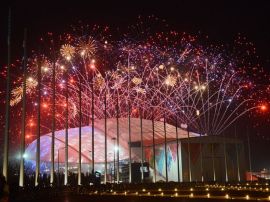
On Friday, 3.5 billion people worldwide tuned in to see how Russia would leave its mark on Olympic history through an ambitious performance at Opening Ceremonies in the recently developed Fisht Olympic stadium. The Fish Olympic stadium stands at a height of 85m, roughly 25 stories, and has the capacity to hold 40,000 attendees. The ceremony lasted 2 hours and 40 minutes and featured three thousand performers, two thousand volunteers, and six thousand costumes. Viewers ‘traveled’ through Russia’s history, with ballet, breath-taking sets, and with 22.5 tons of fireworks set off, it is no wonder that the evening was a spectacular show!
 Another festive feature of the Sochi Olympic winter games comes in the form of five adorable mascots. Three of the Mascots take the form of woodland creatures: the hare, the leopard, and the polar bear. The polar bear, although he loves speed-skating, skiing and curling, is the biggest fan of the bobsledding sporting events. The hare loves to sing and dance and she represents a universal love for the Olympic games. The leopard loves to snowboard, but is a rescuer at heart, representing the idea of a global commitment to help others.
Another festive feature of the Sochi Olympic winter games comes in the form of five adorable mascots. Three of the Mascots take the form of woodland creatures: the hare, the leopard, and the polar bear. The polar bear, although he loves speed-skating, skiing and curling, is the biggest fan of the bobsledding sporting events. The hare loves to sing and dance and she represents a universal love for the Olympic games. The leopard loves to snowboard, but is a rescuer at heart, representing the idea of a global commitment to help others.

The final two mascots come in the form of a pair and rarely separate themselves from one another. They are The Ray of Light and The Snowflake. According to the official Sochi 2014 Olympic games description, both the ray of light and the snowflake faced discrimination when they appeared on earth because they were different than human beings. However, quickly people came to see how genuine and kind both the ray of light and snowflake were and as a result grew to love them. Both mascots connected with human beings through skiing related events and represent the true personification of harmony as well as the need for an absence of discrimination around the globe.
As the games kick off there is a sense of pride all throughout Massachusetts as the state sending the 10th most athletes to the games (a total of 230 USA athletes will be competing). Athletes from MA can be seen throughout various sporting events such as bobsledding and figure skating. Six out of the ten athletes representing Massachusetts are a part of The US Hockey team competing in the games! Wow!
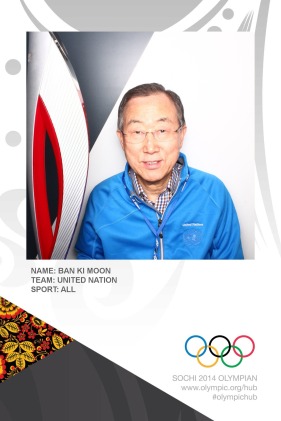 Now that you know more about the Sochi Winter Olympic games, we here at UNA-GB hope that you are just as excited as we are to experience the coming together of cultures from all over the world for two weeks! We look forward to celebrating another successful winter Olympics filled with friendly competition and an underlying theme of teamwork on a global scale to combat issues that effect us all. As Ban Ki-moon said in this address “The Olympics (and Paralympics) have served to break down negative stereotypes and build positive attitudes;” let’s all celebrate what the Olympics is supposed to be: the global community brought together by the games and revel in the power of sport to unify people.
Now that you know more about the Sochi Winter Olympic games, we here at UNA-GB hope that you are just as excited as we are to experience the coming together of cultures from all over the world for two weeks! We look forward to celebrating another successful winter Olympics filled with friendly competition and an underlying theme of teamwork on a global scale to combat issues that effect us all. As Ban Ki-moon said in this address “The Olympics (and Paralympics) have served to break down negative stereotypes and build positive attitudes;” let’s all celebrate what the Olympics is supposed to be: the global community brought together by the games and revel in the power of sport to unify people.
Keep up with Sochi news, medals, etc here.
Westwood Women Unite Against FGM – WF 2014 Kick-off Event
On Tuesday, January 28th, the Women’s Forum held the first of many exciting events of 2014! Attendees gathered at the home of a Women’s Forum Steering Committee member to learn more about Women’s Forum, hear from current members, network, win prizes, and enjoy mouth-watering international cuisine! The night also included a screening of the maternal mortality segment of the film “Half the Sky” followed by a lively and inspirational discussion of this vital women’s issue.
“Half the Sky” is a documentary by Nicolas Kristof and Sheryl WyDunn based on the best-selling book, Half the Sky: Turning Oppression into Opportunity for Women Worldwide. The film and book focus on central issues that women and girls face in communities around the world.
One area that the maternal health segment focuses on is female genital mutilation in Somaliland and the health implications of such practices. The film addresses the cultural practice as well as the economic necessity for women cutters whose livelihood and survival depends on the tradition. Attendees of the event questioned what it would take to end the practice, as it was mentioned that Westerners telling a community such as the one in Somalia that it needs to end a long-standing tradition is ineffective. Many attendees agreed that education, as was mentioned in the film, plays an important role in establishing lasting and sustainable change.
The film presented one example of education and sustainable change through Edna Adan Ismail. Edna’s passion for the women of Somaliland led her to establish a maternal hospital whose mission is to not only to care for women giving birth and train midwives and health professionals, but to train peers to educate the current and next generation of mothers and fathers on female genital mutilation.
The Women’s Forum chose this segment of the film to screen, as maternal mortality is a pervasive issue that is not getting the attention and resources it deserves. As a UN Millennium Development Goal, nations have only achieved a 47% (2010) decrease in maternal mortality rates since 1990, far from the original goal of 75% by 2015. The screening was intended to start a dialogue on what we can do as individuals and as a collective whole to continue to raise awareness and create solutions to maternal mortality and other preventable health issues women face around the world.
Some facts about maternal mortality:
- “Maternal mortality has declined by about two-thirds in Eastern Asia, Northern Africa and Southern Asia.”
- “Complications during pregnancy or childbirth are one of the leading causes of death for adolescent girls.”
- “Most maternal deaths in developing countries are preventable through adequate nutrition, proper health care, including access to family planning, the presence of a skilled birth attendant during delivery and emergency obstetric care”
With International Women’s Day around the corner stay tuned for the UNAGB Women’s Forum next event! We hope to see you there!
– Kendall, WF Steering Committee Member
Sources:
http://www.halftheskymovement.org/
Journey Through the Past: Remembering the Holocaust
On November 1, 2005, the United Nations General Assembly passed resolution 60/7, declaring the 27th of January to be the annual International Day of Commemoration in Memory of the Victims of the Holocaust. While the atrocities committed will forever be remembered as a dark period in global history, the resolution itself uses the 27th of January to reaffirm the Universal Declaration of Human Rights and the proclamation that everyone is entitled to all the rights and freedoms regardless of race, religion, or any status.
Each year, the International Day of Commemoration in Memory of the Victims of the Holocaust is observed through a different theme, highlighting the struggles and deeply evoked emotions from the dark period. Through these themes, the UN is able to recall the tragedies and violations of human rights that occurred during the Holocaust, explicitly demonstrating how detrimental hatred, bigotry, racism, and prejudice can be. Furthermore, the event serves as an opportunity to encourage global awareness and education, taking away lessons for future generations to learn about the Holocaust with the goal of preventing future travesties from occurring.
This year’s theme, “Journeys through the Holocaust”, reflects on the different passages of the Holocaust, revisiting the process of losing individual rights and freedom through incarceration within the concentration camps, where victims were held in contempt up until the moment of liberation, when the concentration camps were closed by Allied Forces. This journey captures the rollercoaster emotions Holocaust victims faced through their morose experience within the camps, only to be reinvigorated with new life once they were rescued. The Holocaust and the United Nations Outreach Programme look to use this years theme as a ‘guiding force’ for future generations to better understand the struggles of genocide, and to emphasize the fact that everyone has a right to life, liberty, and security of person.
The key note speaker for this years Holocaust Memorial Ceremony on International Day of Commemoration in memory of the victims of the Holocaust in NYC will be Academy Award winning Director and USC Shoah Foundation founder, Steven Spielberg. Spielberg, well-known for his contributions to the film industry, is also highly regarded for his contributions to human activism. The Shoah Institute for Visual History and Education was founded in 1994, after directing Schindler’s List, Spielberg was inspired to capture video testimonies from Holocaust survivors before they would be lost forever. This years ceremony will mark the 20th anniversary of the partnership between the USC Shoah Foundation, and The Holocaust and the United Nations Outreach Programme.

A memorial honoring the victims of the Holocaust at Dachau Concentration Camp
Why Should you learn more about the Holocaust?
The Holocaust was one of the greatest tragedies in the history of mankind, with the result of the murder of one third of the Jewish people, alongside countless members of minority groups. The aftermath of the tragedy truly puts into perspective how dangerous hatred, racism, and bigotry can be. Therefore, It is important to raise awareness about the Holocaust, to further prevent future acts of genocide from occurring as much as possible.
“My hope is that our generation, and those to come, will summon that same sense of collective purpose to prevent such horror from happening again anywhere, to anyone or any group,” Mr. Ban said in his remarks at the Park East Synagogue Memorial Service in honour of the victims of the Holocaust.”
-Secretary-General Ban Ki Moon
Learn More about the Holocaust
To become better informed and promote global awareness of the Holocaust, the Holocaust and the United Nations Outreach Programme is partnering with the United States Holocaust Memorial Museum to make a new film resource and educational package available to educators around the world in all United Nations official languages: Arabic, Chinese, English, French, Russian, and Spanish.
http://www.ushmm.org/learn/introduction-to-the-holocaust/path-to-nazi-genocide
In addition, the Holocaust and the United Nations Outreach Programme and the United States Holocaust Memorial Museum offer more information on the Holocaust on the link below:
http://www.un.org/en/holocaustremembrance/PDF/Introduction%20to%20the%20Holocaust.pdf
– Shivam, UNA-GB intern
A Brief History of the Mighty Sushi Roll
Hello readers!
We hope that you all are excited for the Young Professionals cultural event TONIGHT, Sushi Rolling Night with Young Professionals! Have a look at the interesting facts about the history of sushi to prepare you for the amazing cultural event that is in store for you this week!

The first meaning of the Chinese symbol for sushi is believed to be “those made with fish”, then became “food where fish is pickled by rice and salt”. This cuisine bares little resemblance to the Japanese sushi we enjoy now!
With sushi readily available to most cultures around the world due to globalization, it has rapidly become a popular dish around the globe and even a symbol of Japanese culture. However, the sushi that most cultures experience today is not exactly how it was introduced to Japan during it’s inception. There are many forms of sushi that exist. The very first form of sushi introduced in Japan was called Narezushi. During the process of creating the Narezushi form of sushi, raw fish were stuffed with rice and then placed through a fermentation process. The fermentation process would take a couple of months until it was almost complete. Before the process of fermentation was complete, the fish stuffed with rice were prepared for people to eat in order to save the rice from dissolving. It wasn’t until the 19th century that Japanese sushi was transformed into more of a commonly produced food.
During the 19th century, as commoners began to receive permission to create businesses of their own, sushi transformed into a new form called edomaezushi, and became a type of fast food in Japan. Raw pieces of fish were placed on top of rolled squares of rice infused with vinegar. During this time, merchants were forced to become creative in the preservation of the fish used for sushi as raw fish spoils quickly. Depending on the type of fish they were using, merchants would cover their product in salt, wasabi, vinegar, or soy sauce. This allowed merchants to keep their product for a longer, although still limited, amount of time. Edomaezushi is now popular all throughout the world and sometimes changes shape to compliment other cultures. In the United States some types of Edomaezushi come with an assortment of sauces that you wouldn’t typically see in Japan.
Sushi has made a drastic change in America. A prime example of this change can be seen with the extremely popular California roll. There is a legend that says Japanese sushi chef Ichiro Mashita is actually the chef that created the California roll. Upon opening one of the very first restaurants that featured a sushi bar in Los Angeles, Mashita wanted to find a substitute for Toro (fatty tuna) in his cuisine. He realized that avocado holds the same greasy texture of Toro and decided to use it as a substitute. He also turned the roll inside out in order to appease his American customers who did not like seeing the Nori (dried seaweed) when eating their sushi, which is how you would typically order sushi in the U.S. today. The type of sushi that Mashita crafted is actually called Makizushi, which is translated as “rolled sushi”. Makizushi and Edozushi are some of the most popular ways that sushi is experienced within the United States!
Now that you have some background into the history of sushi and the different ways it can be experienced we hope that you will join us and your fellow YP’s at Sushi Rolling Night!!
Human Rights Day 2013: “Twenty years working for your rights
It’s time to celebrate human rights!
Human Rights Day was first declared on December 10, 1950, to celebrate and remind the world each year of the creation of the Universal Declaration of Human Rights. This year marks twenty years since the establishment of the Office of the UN High Commissioner for Human Rights, which was created to carry out the Vienna Declaration and Plan of Action of 1993. The UN calls this list of goals the “the most significant human rights document produced in the past 40 years”.
In celebration of Human Rights Day, UNA-GB wants to help inform its readers about both the history of human rights and the difficulties that arise when trying to define and uphold basic rights for the entire world.
History of Human Rights Day
Lessons learned from the failure to stabilize relations between powerful countries after WWI (and the huge amount of death and destruction that ensued) inspired countries to create an international governmental body, the League of Nations. However, it wasn’t until the end of WWII that the stage was set for the institutionalization of our current system of international cooperation. In 1945, the United Nations was born. One of the UN’s first tasks and top priorities was to create a universal set of standards to ensure that the human rights atrocities of the past decades would never again happen unchecked.
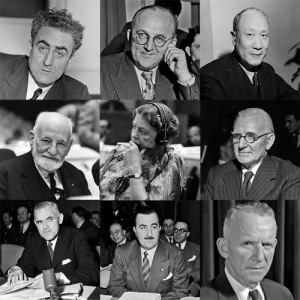
Drafters of the UN Declaration of Human Rights, representing Lebanon, the USSR, China, France, the US, the UK, Australia, Chile, and Canada.
The 10th of December, 1948, is the date the UN General Assembly adopted the Universal Declaration of Human Rights. It outlines the basic human rights that should be guaranteed to individuals, starting at the most basic: the right to life and freedom. It describes the responsibility of society to ensure these rights, also including freedom of thought and speech, religion, association, and culture.
Eleanor Roosevelt was a major contributor to the commission that drafted the declaration. She had become an active voice for human rights domestically during her husband’s presidency, and was offered a position on the delegation to the UN after he died in office. After it was drafted, she vouched for the UNDHR to function as a moral call to action rather than a legal treaty. She wanted the language of the treaty to be easily understood by the general public, and hoped that it would rally the people to the world to take back their rights. Now, its provisions have been worked into most national constitutions since its creation, and have become accepted as international law.
UN Day would be announced in 1950, and has served to remind the world about the gains and ground yet to cover each year in the realm of human rights.
Focus: the Rights of Indigenous Peoples in Nepal
Indigenous peoples are just one of many groups that are at high risk to become victims of human rights infractions. Indigenous people are defined in international or national legislation as having a set of specific rights based on their historical ties to a particular territory, and their cultural or historical distinctiveness from other populations that are often politically dominant.
It is difficult to determine whether or not a group is “indigenous;” the name can refer to a minority group, a society that falls outside of the realm of nation-state politics, a tribe or nomadic people, or any other group that has deep ancestral ties. In a world that continuously becomes more interconnected, there are many implications for populations that are not under the complete jurisdiction of classic societal frameworks or governments. These peoples tend to be at high risk for exploitation, marginalization, and other human rights infractions.
The Nepal Federation of Indigenous Nationalities estimates that about 37% of the population of Nepal can be called indigenous peoples.
The Newa people, who have been the focus of a UN fellowship that strives to learn about and advocate for indigenous rights, are believed to have had huge impacts on the culture, architecture, and history of Nepal today. Their language, Nepal Bhasa, was the official language of Nepal between the 14th and 18th centuries. One of the gravest problems concerning all of the indigenous people of Nepal is the threat of disintegration of their language and culture.
However, the issue of cultural preservation is complex. For example, another group in Nepal, the Dalits, belong (historically) to the lowest caste in of society (they and similar groups are traditionally known as “untouchables” in both Nepal, India, Bangladesh, Sri Lanka, and Pakistan). Discrimination against this group has undeniably caused human rights to be violated in many instances. How does one honor culture while also ensuring that the wishes and rights of these groups are represented in the international governing structure?
Other challenges concerning the land that indigenous people live on and their status in society are common. They are often victims of biopiracy when ancient foods, medicines, etc. are discovered and patented by foreign companies. In Nepal and India, this is particularly a threat in the realm of medicinal plants.
Nepal was the first country in South Asia to ratify the ILO Indigenous and Tribal Peoples Convention 169, which deals with the rights of indigenous peoples. The UN has taken a number of strides to help recognize the unique needs of indigenous peoples. The United Nations Declaration of Rights of Indigenous Peoples was adopted in 2007, and an Expert Mechanism on the Rights of Indigenous Peoples was established within the Human Rights Council.
What You Can Do This Human Rights Day:
1) Celebrate the Life of Nelson Mandela:
This year, celebrate the life of Nelson Mandela, whose successes symbolize the difference that ethical leadership and activism can make when ensuring basic human rights are granted to a people. Mandela fought hard against discrimination and was deeply devoted to equality, and the outcomes of his battle against oppression were some of the greatest human rights successes of our time.
2) Get Informed:
- This Human Rights Day, pick an indigenous group and learn about it! Strike up a conversation with friends and share what you know.
- Check out this list of stories about some of the most prevalent Human Rights issues that face societies around the world.
- Read about Rajani Maharjan’s work with the Newa People in Nepal here
- Read the UN Declaration of Human Rights here
3) Recognize what we need to do next and remember how far we have come :
- A list of Human Rights Achievements can be found on the Human Rights Day website
4) Start a Conversation
- Take what you’ve learned and share it with a friend, classmate, colleague, or family member
- Join the conversation with @UNrightswire on Twitter (#UNRightsAt20)
- Like UN Human Rights on Facebook
Happy Human Rights Day!
Fall 2013: Meet the Interns!
I am a second year graduate student studying international affairs at Boston University. My area of focus is theory and policy and I am very much interested in Latin America, specifically Brazil. I was originally born in Florida but my parents are from Peru and El Salvador. My heritage has played such a significant part in my professional interests that I decided to major in Portuguese and Spanish for my undergraduate studies. During my free time, I love to go salsa, forro, and samba dancing and spend time with my husband, friends and family. I also love traveling; visiting Brazil has been one of the highlights of my travels. One place I would love to travel to is Greece; I spent the summer studying abroad in Geneva, Switzerland and visited many other places in Europe yet did not have enough time to squeeze in Greece. Ultimately, my dream job would be to work in international development focusing on improving the lives of children, their families and communities.
Eliza Berg
I am currently a senior at Boston University studying International Relations and Women’s, Gender and Sexuality Studies and I am very excited to continue my internship at UNA-GB! Originally from a small town in New Hampshire, I have slowly become accustomed to the busy city life in Boston and I love all of the diverse opportunities for research, networking, performance, and art (to name a few) here! One of my favorite things to do in Boston is take walks along the esplanade next to the Charles River, and to eat delicious food at restaurants and cafes with a variety of cuisines. I’ve made it my goal to go to one restaurant per month that features food from a different area of the world (which should be easy with YP’s awesome “Taste Of” events!) One of the places that I have always wanted to visit is Morocco, and I am finally getting the opportunity to go to Rabat in January to do some independent research! I would also love to visit other North African and Middle Eastern countries, and I love learning the Arabic language. For these reasons (and because of my research interests) I hope to one day work for a non-profit or government agency that promotes women’s rights in the MENA and other developing countries.
Jennifer Bleiwise
I am a senior at Northeastern University studying International Affairs with minors in Political Science and History. I’m from a small town in central New Jersey. I love traveling abroad, and I have studied abroad multiple times and have done internships abroad as well. I have studied in England, Austria, the Czech Republic, and France, and did two different internships in Northern Ireland. I really enjoyed studying in Austria and the Czech Republic because I have both Austrian and Czech heritage. Every city I have been to is beautiful and charming in its own way, but if I had to go back to one, I would buy a one way ticket to Belfast, Northern Ireland. My dream job would probably be to be a country singer!
Alyssa Russell
I am a senior at Boston University studying International Relations and Public Relations. I am originally from Falmouth, MA, which is on Cape Cod. I have always loved anything and everything to do with the ocean. In my free time, I love to read, walk or hike outside, write, and explore wherever I happen to be living! Last year, I studied abroad in Paris, France, doing an internship program. I learned so much and got to travel all over Europe; it’s hard to choose, but I think that my favorite place was Edinburgh, Scotland. I loved the medieval feel of the city, the natural beauty both in and around the city, and the people- and I even got to see a fire festival while I was there! If I had a time machine, I would want to go to the lost Inca city at Machu Picchu. I have two dream jobs: one would be to be a highly-in-demand travel blogger, paid to travel all over the world and write about it, and the other would be to work for an international nonprofit, maybe doing conservation or development work.
I am a sophomore at Northeastern University studying International Affairs and am from Chicago, IL. This semester my free time has been devoted to movie hopping–seeing three movies for the price of one–and creating homemade conditioners. I have been to the movies about three times this semester and seen five movies, my goal is to see all of the films that have been given the Oscar nod. I would definitely go to Morocco. I am fluent in French but miss being around french speakers, although Morocco isn’t the first place people go to practice their french I have recently become fascinated with their presence in North Africa. My dream job is to be an international super star like Celine Dion! If I could, I would go into the future to see myself at age 30. I’m curious to know what I will be doing for a living, what friends I will have and if I have kept any, what my younger siblings would be doing, where I will be living, and what the world would be like.

Top 5 Reasons Why You Should Attend UN Day Luncheon 2013!
It’s officially fall (and pretty chilly in Boston)…which means it’s once again time to celebrate United Nations Day with UNA-GB! The office honored UN Day last week on October 24th by raising the UN flag above Boston City Hall, did anyone spot it?
UN Day, which has been celebrated every year since 1948, recognizes the creation of the United Nations and its founding principles of peace, cooperation, and collective action. This year, Secretary General Ban Ki-moon echoed these founding ideals in his address: “we continue to show what collective action can do. We can do even more. In a world that is more connected, we must be more united. On United Nations Day, let us pledge to live up to our founding ideals and work together for peace, development, and human rights.”
In a more formal celebration of UN Day, UNA-GB is hosting its annual UN Day Luncheon on Tuesday, November 5th (next week!) from 12:30 to 2 pm at the Boston Park Plaza Hotel. Why should you honor us with your attendance? Here are a few reasons we can think of!
1) Ambassador Nicholas Burns will be there.
Not only will he be there – he’ll be delivering the keynote speech on “America’s Global Challenges 2014.” Ambassador Burns served in the US Foreign Service for twenty-seven years, during which time he was appointed Under Secretary of State for Political Affairs, Ambassador to NATO, Ambassador to Greece, and State Department Spokesman.
He worked on the National Security Council staff as Senior Director for Russia, Ukraine, and Eurasia Affairs and was Special Assistant to President Clinton and Director for Soviet Affairs for President George H.W.Bush. He is currently Professor of the Practice of International Relations at the Harvard Kennedy School of Government, Director of the Future of Diplomacy Project and Faculty Chair for the Programs on the Middle East and on India and South Asia, as well as Director of the Future of Diplomacy Project. Burns is also the Director of the Aspen Strategy Group, Senior Counselor at the Cohen Group, and serves on the Board of Directors of Entegris, Inc.
You may have read some of his work in The Boston Globe, where he writes a bi-weekly column on foreign affairs.
2) Special guests, Georg Kell and Jonas Haertle will also be there.
Mr. Kell and Mr. Haertle are this year’s Global Corporate Citizenship Honor Roll guests! The honor roll recognizes Massachusetts-based companies who have signed on to key business principles through the UN Global Compact.
Georg Kell is the Executive Director of the UN Global Compact, the world’s largest voluntary corporate sustainability initiative with 8,000 corporate participants in 145 countries. A key architect of the Global Compact, he has led the initiative since its founding in 2000, establishing the most widely recognized multi-stakeholder network and action platform to advance responsible business practices. Mr. Kell joined the United Nations in 1987, and has been at the leading edge of the organization’s private-sector engagement ever since.
Jonas Haertle is Head of the Principles for Responsible Management Education (PRME) secretariat of the United Nations Global Compact Office. The mission of the PRME initiative is to inspire and champion responsible management education, research and thought leadership globally. In his role as coordinator for Global Compact Local Networks he works with the country networks in Latin America and the Caribbean. Mr. Haertle holds a master’s degree in European Studies of Hamburg University. As a Fulbright scholar, he also attained a MSc degree in Global Affairs from Rutgers University.
3) There will be opportunities to network with professionals, consuls, and other individuals who are dedicated to promoting the founding principles of the United Nations!
Members of the UNA-GB, professionals of all ages, Consuls from a variety of Consulates in Boston, and most importantly, YOU will have the opportunity to discuss anything from national issues/achievements to the UN’s Millennium Development Goals, to the chilly Boston weather! This is a wonderful opportunity to connect with like-minded people who support the work of the United Nations.
4) It’s a good excuse to get out of the office (or school or the house) and enjoy some delicious food!
Could there be a better incentive? The Boston Park Plaza Hotel will serve some delicious appetizers, entrees, and desserts! It is a chance to spend a few hours out of the office/school, enjoy great company, and have a tasty meal at a swanky hotel…what more could you ask for?
5) You will be supporting UNA-GB’s programs, which aim to educate today’s youth and tomorrow’s leaders!
Funds raised from ticket sales and sponsorships at the UN Day Luncheon directly support UNA-GB’s community events and classroom-based programs, which serve more than 5,000 participants annually in greater Boston.
Convinced? Then what are you waiting for?! Sign up to attend UN Day Luncheon 2013 today!
Written by: Eliza Berg, Programs Intern
UN Day of the Girl Child: “Innovating for Girls’ Education”
On Thursday, October 10th, Katrina Sousounis introduced Girl Rising to about two hundred and sixty attendees at a film screening hosted by UNA-GB. She explained that the most pervasive issues affecting the people of the world today (including poverty, malnutrition, illiteracy, violence) disproportionately affect young women. Katrina finished the speech with a call for educational reform to give opportunities to women everywhere, and ended with this quote from the film: “Boys need to believe in girls, and girls need to learn to believe in themselves.”
Katrina is 13 years old.
Founder of the first Girl Up club in Massachusetts, Katrina was inspired to try and solve the problems so carefully outlined in her speech. Her club is part of an organization founded to help girls and young women around the world to reach their full potential by ensuring that they are educated, safe, well-fed, and guaranteed basic human rights.
Because of this, Katrina was asked to introduce Girl Rising at UNA-GB’s screening of the film on Thursday, which was a fundraiser for Girl Up. Her presence and hard work demonstrate a distinctive part of Girl Up’s message: to help girls reach their potential around the world, we must empower girls themselves to effect the change that they want to see.
Girl Rising is the story of nine girls from around the world: Sokha from Cambodia, Wadley from Haiti, Suma from Nepal, Yasmin from Egypt, Azmera from Ethiopia, Ruksana from India, Senna from Peru, Mariama from Sierra Leone, and Amina from Afghanistan. Each girl was paired with a writer from her country to help tell her story. Each story is artistically captured differently, with varying experiences when it comes to cultural restraints, parental support, and environmental circumstances. In essence, Girl Rising is a movement to deliver a “simple, critical truth: educate girls and you will change the world.”
The UNA-GB decided to screen this film to get a dialogue started to help men, women, boys and girls in Boston and elsewhere think about solutions to various forms of discrimination against girls around the world. After the film, a musical group called “Women of the World”, which sings in 21 different languages, performed. They chose a song that resonated with the idea that together, we can create positive change.
In 2011, the UN declared October 11th as the first annual tribute to its goal to improve gender equality everywhere. This year, the theme of the day is “Innovating for Girls’ Education.” It sounds simple enough, but the task of ensuring that girls worldwide are educated is complex, both in implementation and consequence.
What exactly is keeping girls from going to school?
A wide breadth of causes keep girls out of school each day. Governmental policies and social issues alike can keep girls and boys out of school. Here are a few major perpetrators:
- School is not free everywhere, and many poor families cannot afford to send any or all of their children to school. In some countries, boys are sent to school while girls stay home and work.
- It can be dangerous: in 2012, Save the Children reported that there were more than 3,600 attacks on education around the world.
- About half of all girls living in the world’s least developed countries are married before the age of 18. Child marriage greatly decreases a girl’s likelihood of finishing school, according to World Vision.
- Lack of sanitary protection means that girls may miss up to five days of school a month
- When basic needs aren’t being met and students are not healthy or well-fed, school may be a low priority.
- There may not be a school within walking distance, especially in rural areas.
- Governmental policies and societal norms can make it illegal or abnormal for girls to become educated
So, how exactly does educating girls help the world?
- According to the UN: “When girls are able to stay in school and avoid being married early, they can build a foundation for a better life for themselves and their families and participate in the progress of their nations.”
- Educated mothers educate their children; this not only breaks the cycle of poverty, but their sons will be more inclined to educate their daughters.
- UNICEF connected discrimination against women and girls and hunger. Child malnutrition in South Asia is highly linked to women’s limited access to education and difficulties with finding paid employment.
What can you do?
- Education, education, education! Educate yourself by exploring the issue even more- try checking out some of the links below
- Donate! Visit Girl Up’s website, or one of the other initiatives below, to give to the cause.
- Become an activist! Join one of the causes below, or create your own!
Happy International Day of the Girl Child!
Sources/More Information:
School Girls Unite!
Girl Rising
Girl Up
UN Day of the Girl Child
http://www.un.org/en/events/girlchild/index.shtml
http://dayofthegirl.org/actnow/
http://www.huffingtonpost.com/2013/10/11/international-day-of-girl-child_n_4080681.html?utm_hp_ref=impact

